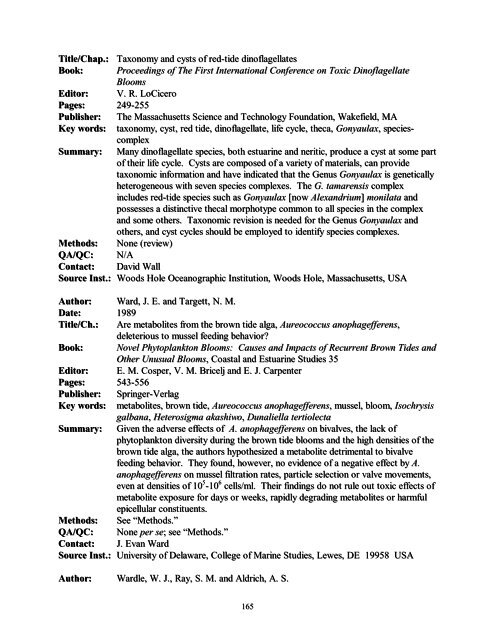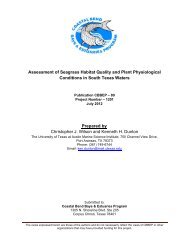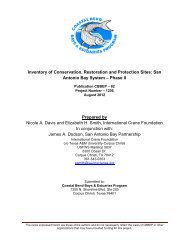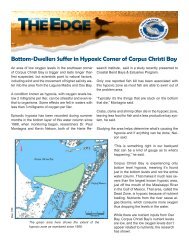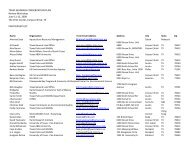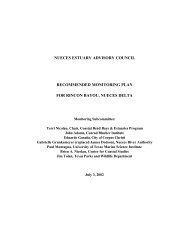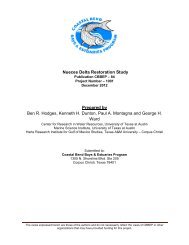QA/QC: None per se; see “Data Base” <strong>and</strong> “Analysis <strong>and</strong> Results.”Contact: Mario E. C. VieiraáSource Inst.: Oceanography Department, US Naval Academy, Annapolis, MD 21402-5026USAAuthor: Walker, L. M.Date: 1982Title: Evidence for a sexual cycle in the Florida red tide din<strong>of</strong>lagellate, Ptychodiscusbrevis (= Gymnodinium breve)Journal: Transactions <strong>of</strong> the American Microscopical Society 101(3):287-293Key words: sexual cycle, Florida, red tide, din<strong>of</strong>lagellate, Gymnodinium breve, gametes,planozygotes, cystSummary: Non-clonal stock cultures provided evidence <strong>of</strong> isogamous, haploid gametes <strong>and</strong>diploid planozygotes in the sexual cycle <strong>of</strong> Gymnodinium breve. Though nohypnozygotes were ever positively identified in the cultures, apparenthypnozygotic cysts may have formed in one preliminary experiment <strong>and</strong> were alsorecovered from field samples.Methods: See "Materials <strong>and</strong> Methods."QA/QC: None per se; see "Materials <strong>and</strong> Methods."Contact: Linda M. WalkerSource Inst.: Florida Department <strong>of</strong> Natural Resources, Marine Research Laboratory, 100Eighth Avenue South East, St. Petersburg, Florida 33701-5095 USAAuthor: Walker, L. M., <strong>and</strong> Steidinger, K. A.Date: 1979Title: Sexual reproduction in the toxic din<strong>of</strong>lagellate Gonyaulax monilataJournal: Journal <strong>of</strong> Phycology 15:312-315Key words: reproduction, din<strong>of</strong>lagellate, Gonyaulax monilata, sexual cycle, isogametes,planozygote, hypnozygote, archeopyle, red tide, seed bedSummary: The authors observed the induction <strong>of</strong> the sexual cycle <strong>of</strong> Gonyaulax [nowAlex<strong>and</strong>rium] monilata in nonclonal laboratory cultures within one week afterinoculating asexual cells into nitrogen-deficient media. Asexual cells can producetwo armored, motile, isogamous gametes. Two gametes fuse to form a largedouble-flagellated planozygote that encysts as a hypnozygote with a three-layeredcyst wall 1-3 weeks later. The cell that emerges from the cyst divides twice t<strong>of</strong>orm a four-celled chain within three days. The authors report that cysts <strong>of</strong> G.monilata were found in Tampa Bay sediments, were excysted <strong>and</strong> produced chains<strong>of</strong> cells identical to those studied in the nonclonal laboratory cultures.Methods: See "Materials <strong>and</strong> Methods."QA/QC: None per se; see "Materials <strong>and</strong> Methods."Contact: Linda M. WalkerSource Inst.: Florida Department <strong>of</strong> Natural Resources, Marine Research Laboratory, 100Eighth Avenue S.E., St. Petersburg, FL 33701Author: Wall, D.Date: 1975164
Title/Chap.: Taxonomy <strong>and</strong> cysts <strong>of</strong> red-tide din<strong>of</strong>lagellatesBook: Proceedings <strong>of</strong> The First International Conference on Toxic Din<strong>of</strong>lagellateBloomsEditor: V. R. LoCiceroPages: 249-255Publisher: The Massachusetts Science <strong>and</strong> Technology Foundation, Wakefield, MAKey words: taxonomy, cyst, red tide, din<strong>of</strong>lagellate, life cycle, theca, Gonyaulax, speciescomplexSummary: Many din<strong>of</strong>lagellate species, both estuarine <strong>and</strong> neritic, produce a cyst at some part<strong>of</strong> their life cycle. Cysts are composed <strong>of</strong> a variety <strong>of</strong> materials, can providetaxonomic information <strong>and</strong> have indicated that the Genus Gonyaulax is geneticallyheterogeneous with seven species complexes. The G. tamarensis complexincludes red-tide species such as Gonyaulax [now Alex<strong>and</strong>rium] monilata <strong>and</strong>possesses a distinctive thecal morphotype common to all species in the complex<strong>and</strong> some others. Taxonomic revision is needed for the Genus Gonyaulax <strong>and</strong>others, <strong>and</strong> cyst cycles should be employed to identify species complexes.Methods: None (review)QA/QC: N/AContact: David WallSource Inst.: Woods Hole Oceanographic Institution, Woods Hole, Massachusetts, USAAuthor: Ward, J. E. <strong>and</strong> Targett, N. M.Date: 1989Title/Ch.: Are metabolites from the brown tide alga, Aureococcus anophagefferens,deleterious to mussel feeding behavior?Book: Novel Phytoplankton Blooms: Causes <strong>and</strong> Impacts <strong>of</strong> Recurrent <strong>Brown</strong> <strong>Tide</strong>s <strong>and</strong>Other Unusual Blooms, Coastal <strong>and</strong> Estuarine Studies 35Editor: E. M. Cosper, V. M. Bricelj <strong>and</strong> E. J. CarpenterPages: 543-556Publisher: Springer-VerlagKey words: metabolites, brown tide, Aureococcus anophagefferens, mussel, bloom, Isochrysisgalbana, Heterosigma akashiwo, Dunaliella tertiolectaSummary: Given the adverse effects <strong>of</strong> A. anophagefferens on bivalves, the lack <strong>of</strong>phytoplankton diversity during the brown tide blooms <strong>and</strong> the high densities <strong>of</strong> thebrown tide alga, the authors hypothesized a metabolite detrimental to bivalvefeeding behavior. They found, however, no evidence <strong>of</strong> a negative effect by A.anophagefferens on mussel filtration rates, particle selection or valve movements,even at densities <strong>of</strong> 10 5 -10 6 cells/ml. Their findings do not rule out toxic effects <strong>of</strong>metabolite exposure for days or weeks, rapidly degrading metabolites or harmfulepicellular constituents.Methods: See “Methods.”QA/QC: None per se; see “Methods.”Contact: J. Evan WardSource Inst.: University <strong>of</strong> Delaware, College <strong>of</strong> Marine Studies, Lewes, DE 19958 USAAuthor: Wardle, W. J., Ray, S. M. <strong>and</strong> Aldrich, A. S.165
- Page 1 and 2:
Current Status and Historical Trend
- Page 3 and 4:
Current Status and Historical Trend
- Page 5 and 6:
Barry R. McBee, ChairmanR. B. Ralph
- Page 7:
STUDY AREA DESCRIPTIONThe CCBNEP st
- Page 10 and 11:
TABLE OF CONTENTSPagePREFACE.......
- Page 12 and 13:
LIST OF TABLESBROWN TIDETablePage1.
- Page 14 and 15:
LIST OF FIGURESFigurePage38. Growth
- Page 16:
indicating that brown tide was a po
- Page 19 and 20:
Organism:AureococcusanophageffernsT
- Page 21:
Perhaps the most important impact o
- Page 25 and 26:
Temperature and Salinity for Laguna
- Page 27 and 28:
second residence time was calculate
- Page 30 and 31:
In spite of the warm temperatures a
- Page 32 and 33:
NO 2 concentrations for Laguna Madr
- Page 34 and 35:
SiO 4 concentrations for Laguna Mad
- Page 36 and 37:
Brown Tide Counts Upper Laguna Madr
- Page 39 and 40:
D. Environmental impact1. Seagrasse
- Page 41 and 42:
Station A300Areal Shoot Biomass (gd
- Page 43:
Station A2018Root/Rhizome:Shoot Rat
- Page 47 and 48:
copepods reaching their maximum siz
- Page 49 and 50:
The observed changes in zooplankton
- Page 51 and 52:
Specific Growth Rate (day -1 )1.510
- Page 53 and 54:
Specific Growth Rate (Day -1 )0.70.
- Page 55 and 56:
Percent Survival1009080706050403020
- Page 57 and 58:
culture organism widely used as a f
- Page 59 and 60:
species of phytoplankton, and altho
- Page 61 and 62:
These results are particularly impo
- Page 63 and 64:
Larval AnchovyLarval Density (No./1
- Page 65 and 66:
60Macrofauna DiversityBaffin Bay an
- Page 67 and 68:
ABay AnchovyBStripped Mullet250600N
- Page 69 and 70:
invertebrate die-off in the freezes
- Page 71 and 72:
is a common component of phytoplank
- Page 73 and 74:
VII. Literature CitedAdmiraal, W.,
- Page 75 and 76:
DeYoe, H.R., Chan, A.M., Suttle, C.
- Page 77 and 78:
Milligan, A.J. (1992). An investiga
- Page 79 and 80:
freshwater inflow. Technical Report
- Page 81 and 82:
IX. Historical trends of Texas red
- Page 83 and 84:
Table 1. Selected Texas bays with p
- Page 85 and 86:
Galveston Island on 27 August 1986;
- Page 87 and 88:
quickly banned harvest and shipment
- Page 89 and 90:
The effects of Gymnodinium breve bl
- Page 91 and 92:
Along with favorable salinity level
- Page 93 and 94:
eproduction, but even division rate
- Page 95 and 96:
Though the data in Figure 2 appear
- Page 97 and 98:
extensive list of all fish species
- Page 99 and 100:
circulation patterns could work in
- Page 101 and 102:
Texas, a possibility that may only
- Page 103 and 104:
XIII. Literature CitedAbdelghani, A
- Page 105 and 106:
Hemmert, W. H. (1975). The public h
- Page 107 and 108:
Rounsefell, G. A., Nelson, W. R. (1
- Page 109 and 110:
Williams, J., Ingle, R. M. (1972).
- Page 111 and 112:
Larvae were collected with five rep
- Page 113 and 114:
waters may facilitate photoautotrop
- Page 115 and 116:
Editor: E. M. Cosper, V. M. Bricelj
- Page 117 and 118:
Source Inst.: Mote Marine Laborator
- Page 119 and 120:
QA/QC: None per se; see “Methods.
- Page 121 and 122:
Title/Ch.: Effects of a persistent
- Page 123 and 124:
Key words: red tide, bloom, plankto
- Page 125 and 126:
Key words: brown tide, bloom, chrys
- Page 127 and 128: Author: Cosper, E. M., Garry, R. T.
- Page 129 and 130: Pages: 128-131Publisher: ElsevierKe
- Page 131 and 132: Thesis: Role of environmental varia
- Page 133 and 134: Methods: See “Materials and Metho
- Page 135 and 136: Author: Gallager, S. M., Stoecker,
- Page 137 and 138: Journal: Science 113:250-251Key wor
- Page 139 and 140: QA/QC: None per se; see "Method."Co
- Page 141 and 142: Contact: John F. HowellSource Inst.
- Page 143 and 144: iota and inshore shellfish beds, ta
- Page 145 and 146: Author: Lowe, J. A., Farrow, D. R.
- Page 147 and 148: Date: 1992Thesis: An investigation
- Page 149 and 150: Author: Nixon, S. W., Granger, S. L
- Page 151 and 152: Source Inst.: Fisheries Research an
- Page 153 and 154: Date: 1957Title: Effects of unialga
- Page 155 and 156: Date: 1979Title/Ch.: The effect of
- Page 157 and 158: Book: Toxic Dinoflagellate Blooms,
- Page 159 and 160: Contact: Sandra E. ShumwaySource In
- Page 161 and 162: monilata] and Gymnodinium breve tox
- Page 163 and 164: Source Inst.: Graduate School of Oc
- Page 165 and 166: substantiated for G. breve (though
- Page 167 and 168: Methods: None (review)QA/QC: N/ACon
- Page 169 and 170: Source Inst.: Florida Department of
- Page 171 and 172: 5000 cells/liter, so the cell count
- Page 173 and 174: Key words: red tide, bloom, algae,
- Page 175 and 176: Contact: Gregory A. TraceySource In
- Page 177: Author: Vargo, G. A. and Howard-Sha
- Page 181 and 182: Date: 1993Title/Ch.: The nutrient a
- Page 183 and 184: cell division, other possible repro
- Page 185 and 186: lue light in the same region as tha
- Page 187 and 188: Pat TesterNMFS Southeast Fisheries


